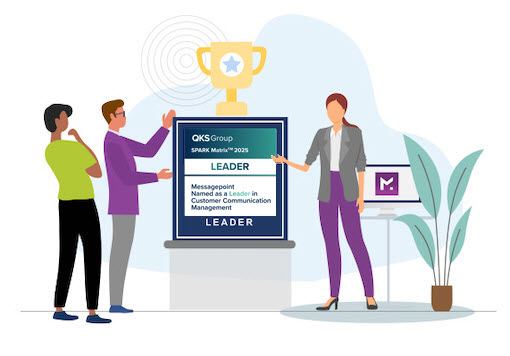
This blog is the fourth part of an ongoing series called “Introducing Customer Touchpoint Messaging 2.0” explaining how Touchpoint Messaging 2.0 simplifies the planning and execution of customer messaging programs.
Before any customer touchpoint leaves your company’s four walls, it’s important to get things right. After all, there’s quite a lot at stake. Messaging needs to be clear, concise, and targeted, otherwise there’s a risk of confusion which generates helpdesk calls and customer dissatisfaction. Messaging needs to comply with laws and regulations; otherwise, your company could be open to liability or penalties. Touchpoints and their content also need to conform to your corporate brand standards or those of your clients, or you risk diluting or damaging your brand image. With the various internal and external stakeholders sharing a vested interest in accuracy, fidelity, and compliance in customer communications, coordinating collaboration and review becomes a pretty critical aspect of your job.
Surprisingly, this critical review and approvals process still takes place largely through email — usually with the help of that same old spreadsheet filled with hundreds, even thousands, of messages and targeting instructions! Not overly efficient, not very reliable, and certainly not leaving a great audit trail, or facilitating effective collaboration.
In a Touchpoint Messaging 2.0 world, just as your messaging platform acts as a repository for user-driven content and targeting throughout the messaging lifecycle, so too should it allow key stakeholders to access, review and approve (and even reject!) content from the comfort of their desktops. It should also serve to orchestrate and facilitate the collaboration and coordination between parties through a flexible, configurable workflow.
Equally important, the content being reviewed should be presented in a way that is clear and contextual to the user, so they’re approving the touchpoint in its entirety, not piecemeal in disparate chunks. Spreadsheet content doesn’t provide a lot of context, but your touchpoint messaging platform should.
And if stakeholders need to preview or proof content prior to committing their approval, that needs to be available on-demand, and not through some pre-production last-minute scramble. Finally, the workflow approvals process needs to capture history – the full chain of approvals throughout the messaging lifecycle which can be used as a bullet-proof audit of activity.
Your Touchpoint Messaging 2.0 platform should serve as an invaluable system of record over time for how messaging has evolved — when it got changed and approved, and who changed or approved it. And it should ultimately allow you to collaborate with greater confidence among key customer communication stakeholders in your organization.
This blog is the fourth part of an ongoing series called “Introducing Customer Touchpoint Messaging 2.0” explaining how Touchpoint Messaging 2.0 simplifies the planning and execution of customer messaging programs.
Before any customer touchpoint leaves your company’s four walls, it’s important to get things right. After all, there’s quite a lot at stake. Messaging needs to be clear, concise, and targeted, otherwise there’s a risk of confusion which generates helpdesk calls and customer dissatisfaction. Messaging needs to comply with laws and regulations; otherwise, your company could be open to liability or penalties. Touchpoints and their content also need to conform to your corporate brand standards or those of your clients, or you risk diluting or damaging your brand image. With the various internal and external stakeholders sharing a vested interest in accuracy, fidelity, and compliance in customer communications, coordinating collaboration and review becomes a pretty critical aspect of your job.
Surprisingly, this critical review and approvals process still takes place largely through email — usually with the help of that same old spreadsheet filled with hundreds, even thousands, of messages and targeting instructions! Not overly efficient, not very reliable, and certainly not leaving a great audit trail, or facilitating effective collaboration.
In a Touchpoint Messaging 2.0 world, just as your messaging platform acts as a repository for user-driven content and targeting throughout the messaging lifecycle, so too should it allow key stakeholders to access, review and approve (and even reject!) content from the comfort of their desktops. It should also serve to orchestrate and facilitate the collaboration and coordination between parties through a flexible, configurable workflow.
Equally important, the content being reviewed should be presented in a way that is clear and contextual to the user, so they’re approving the touchpoint in its entirety, not piecemeal in disparate chunks. Spreadsheet content doesn’t provide a lot of context, but your touchpoint messaging platform should.
And if stakeholders need to preview or proof content prior to committing their approval, that needs to be available on-demand, and not through some pre-production last-minute scramble. Finally, the workflow approvals process needs to capture history – the full chain of approvals throughout the messaging lifecycle which can be used as a bullet-proof audit of activity.
Your Touchpoint Messaging 2.0 platform should serve as an invaluable system of record over time for how messaging has evolved — when it got changed and approved, and who changed or approved it. And it should ultimately allow you to collaborate with greater confidence among key customer communication stakeholders in your organization.

TORONTO, April 24, 2025 –Messagepoint has been named a 2025 SPARK Matrix™ Technology Leader in Customer Communication Management…
Read the Article
Check out the 2025 Spark Matrix for Customer Communication Management, and see why Messagepoint is a leader in…
Read the Article